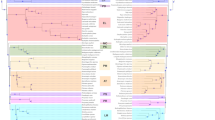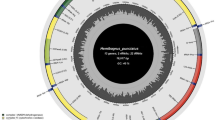Abstract
Partial sequences of the mitochondrial cytochrome b gene of the Korean hare (Lepus coreanus) were analyzed to determine the degree of genetic diversity. Nine haplotypes were observed, and the maximum Tamura–Nei nucleotide distance among them was 2.8%, indicating that genetic diversity of L. coreanus is moderate. In order to clarify the Korean hare's taxonomic status and relationship with the Manchurian hare (L. mandshuricus) and the Chinese hare (L. sinensis), these nine haplotypes of the Korean hare were compared with 13 haplotypes from five other species of eastern Asian Lepus including L. mandshuricus and L. sinensis. The Korean hare was distinct in its cytochrome b gene, and it is confirmed that L. coreanus is a valid species, as noted by Jones and Johnson (1965, Univ. Kansas Publ. (Mus. Nat. Hist.) 16:357). Further analyses of mtDNA cytochrome b gene with additional specimens of L. coreanus from North Korea and other species of Lepus from eastern Asia are needed to clarify the taxonomic status of the divergent mtDNA clades of L. mandshuricus and L. sinensis.
Similar content being viewed by others
REFERENCES
Angermann, R. (1966). Beitrage zur kenntnis der gattung Lepus (Lagomorpha, Leporidae). II. der taxonomische status von Lepus brachyurus Temminck und Lepus mandschuricus Radde. Mitt. Zool. Mus. Berlin 42: 321.
Corbet, G. B. (1978). The Mammals of the Palaearctic Region: A Taxonomic Review, British Museum (Natural History), Cornell University Press, London.
Ellerman, J. R., and Morrison-Scott, T. C. S. (1951). Checklist of Palearctic and Indian Mammals 1758 to 1946, British Museum (Natural History), London.
Flux, J. E. C., and Angermann, R. (1990). The hares and jackrabbits. In Chapman, J. A., and Flux, J. E. C. (eds.), Rabbits, Hares, and Pikas, Status Survey and Conservation Action Plan, IUCN, Switzerland, p. 61.
Halanych, K. M., Demboski, J. R., Van Vuuren, B. J., Klein, D. R., and Cook, J. A. (1999). Cytochrome b phylogeny of North American hares and jackrabbits (Lepus, Lagomorpha) and the effects of saturation in outgroup taxa. Mol. Phylogenet. Evol. 11: 213.
Hillis, D. M., Moritz, C., and Mable, B. K. (1996). Molecular Systematics, 2nd edn., Sinauer Associates, Massachusetts.
Hoffmann, R. S. (1993). Order Lagomorpha. In Wilson, D. E., and Reeder, D. M. (eds.), Mammal Species of the World, Smithsonian Institution Press, New York, p. 807.
Irwin, D. M., K ocher, T. D., and Wilson, A. C. (1991). Evolution of the cytochrome b gene of mammals. J. Mol. Evol. 32: 128.
Jones, J. K., and Johnson, D. H. (1965). Synopsis of the lagomorphs and rodents of Korea. Univ. Kansas Publ. (Mus. Nat. Hist.) 16: 357.
Kim, S. W., and Kim, W. K. (1974). Avi-mammalian fauna of Korea. Wildlife Population Census in Korea, Vol. 5, Forestry Research Institute, Office of Forestry, p. 1 (in Korean).
Mayr, E., and Ashlock, P. D. (1991). Principles of Systematic Zoology, McGraw-Hill, New York.
Moritz, C., and Hillis, D. M. (1996). Molecular systematics: Context and controversies. In Hillis, D. M., Moritz, C., and Mable, B. K. (eds.), Molecular Systematics, 2nd edn., Sinauer Associates, Massachusetts, p. 1.
Perez-Suarez, G., Palacios, F., and Boursot, P. (1994). Speciation and paraphyly in western Mediteranean hares (Lepus castroviejoi, L. europaeus, L. granatensis, and L. capensis ) revealed by mitochondrial DNA phylogeny. Biochem. Genet. 32: 423.
Sunnucks, P. (2000). Efficient genetic markers for population biology. TREE 15: 199.
Tamura, K., and Nei, M. (1993). Estimation of the number of nucleotide substitutions in the control region of mitochondrial DNA in humans and chimpanzees. Mol. Biol. Evol. 10: 512.
Tate, G. H. H. (1947). Mammals of Eastern Asia, MacMillan, New York.
Thomas, O. (1906). The Duke of Bedford's zoological exploration in eastern Asia-II. List of small mammals from Korea and Quelpart. Proc. Zool. Soc. London 858.
Won, P. O. (1961). Studies on the avi-mammalian fauna of Korea from the viewpoint of the foresty protection. In Avi-Mammalian Fauna of Korea, Institute of Agriculture, Ministry of Agriculture and Forestry, Suwon, Korea, p. 31.
Woon, P. H. (1967). Illustrated Encyclopedia of Fauna and Flora of Korea, Vol. 7: Mammals, Ministry of Education, Seoul (in Korean).
Wu, C., Li, H., Wang, Y., and Zhang, Y. P. (2000). Low genetic variation of the Yunnan hare (Lepus comus G. Allen, 1927) as revealed by mitochondrial cytochrome b gene sequences. Biochem. Genet. 38: 147.
Author information
Authors and Affiliations
Rights and permissions
About this article
Cite this article
Koh, H.S., Chun, T.Y., Yoo, H.S. et al. Mitochondrial Cytochrome b Gene Sequence Diversity in the Korean Hare, Lepus coreanus Thomas (Mammalia, Lagomorpha). Biochem Genet 39, 417–429 (2001). https://doi.org/10.1023/A:1013815720609
Issue Date:
DOI: https://doi.org/10.1023/A:1013815720609




